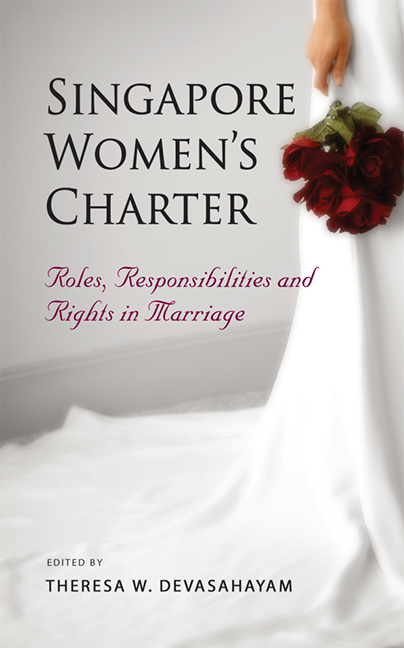Book contents
- Frontmatter
- Contents
- Contributors
- Foreword
- Keynote Address
- 1 Legal Mechanisms for Protecting Women's Rights: Examples from Southeast Asia
- 2 The Women's Charter, 1961: Where We Were Coming From and How We Got There
- 3 Significant Provisions in the Women's Charter
- 4 A Lawyer's Perspective on How Divorcees View the Women's Charter
- 5 “The Morning After”: Understanding and Exploring the Psychosocial Impact of the Women's Charter on Families Experiencing Domestic Violence
- 6 Epilogue: Some Thoughts on Protecting Women's Rights in the Family and Beyond
- Index
3 - Significant Provisions in the Women's Charter
Published online by Cambridge University Press: 21 October 2015
- Frontmatter
- Contents
- Contributors
- Foreword
- Keynote Address
- 1 Legal Mechanisms for Protecting Women's Rights: Examples from Southeast Asia
- 2 The Women's Charter, 1961: Where We Were Coming From and How We Got There
- 3 Significant Provisions in the Women's Charter
- 4 A Lawyer's Perspective on How Divorcees View the Women's Charter
- 5 “The Morning After”: Understanding and Exploring the Psychosocial Impact of the Women's Charter on Families Experiencing Domestic Violence
- 6 Epilogue: Some Thoughts on Protecting Women's Rights in the Family and Beyond
- Index
Summary
The Women's Charter is Chapter 353 of Singapore's statutes. It was originally enacted in 1961 as the common marriage and family statute for non-Muslim Singaporeans. The People's Action Party (PAP) had included as one item in its election manifesto the complete review of Singapore's existing family laws with a view to improving the unsatisfactory state of these laws that were affecting non-Muslim Singaporeans. The statute came into existence when the successful party made good on this promise.
Why the Women's Charter is Noteworthy Even to Non-lawyers
Even to non-lawyers, there are two features of the Women's Charter that make this a statute of note.
Important Tool in National Reconstruction
It is rare to encounter a statute, such as the Women's Charter, the enactment of which by the legislature was so closely bound up with the political development of the nation. The political party that won the first general election to the legislature held in Singapore in 1959, and has remarkably continued its winning streak since then, rightly envisioned national reconstruction to require the efforts of both men and women equally: “[W]e stand for equality … of opportunity for education and employment for all Singapore citizens.” Thus the political leaders wisely believed in raising the status and marital condition of the majority of women:
Women who form nearly half of our population have an important part to play in our national construction. In the first instance in order to emancipate them from the binds of feudalism and conservatism a monogamous marriage law will be passed.
Indeed the PAP moved the enactment of the Women's Charter in the first session of the First Legislative Assembly of the State of Singapore on 2 March 1960.
Value of giving women equality within their marriage
The enactment of the Women's Charter was thus a momentous event in the relatively short history of Singapore.
- Type
- Chapter
- Information
- Singapore Women's CharterRoles, Responsibilities and Rights in Marriage, pp. 79 - 112Publisher: ISEAS–Yusof Ishak InstitutePrint publication year: 2011

